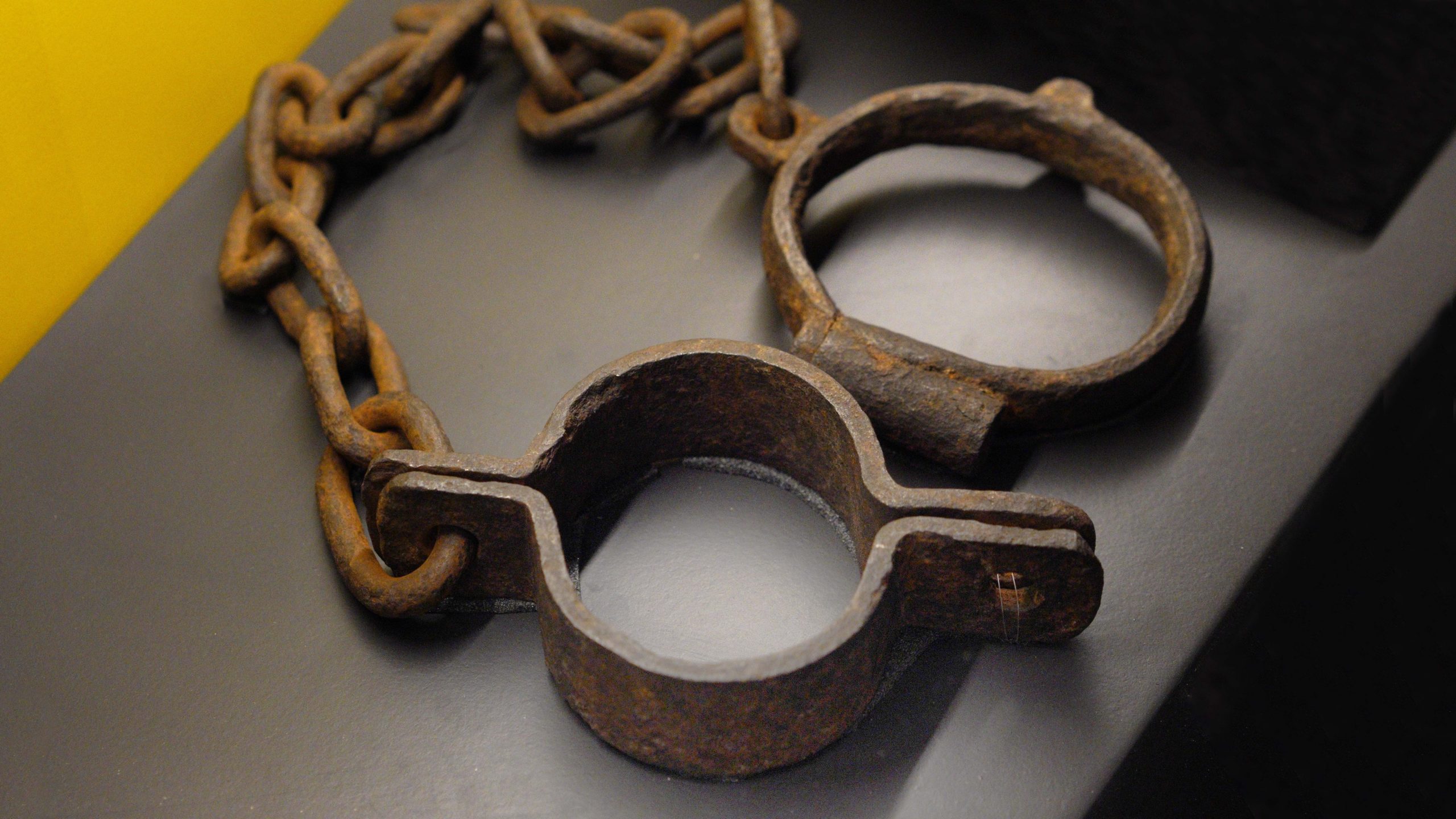
Leg shackles used to restrict the movement of enslaved people, 19th century, iron (Museum of the Civil War, Richmond; photo: Steven Zucker, CC BY-NC-SA 2.0)
Slavery has never been represented; Slavery never can be represented. . . . I may try to represent to you Slavery as it is; another may follow me and try to represent the condition of the Slave; we may all represent it as we think it is and yet we shall all fail to represent the real condition of the Slave.
William Wells Brown, From A Lecture Delivered before the Female Anti-Slavery Society of Salem, November 14, 1847
This quote, from William Wells Brown—who escaped from slavery in 1834—testifies to the impossibility of representing the experience of enslavement, even by someone who was enslaved. Artifacts often encountered in museum settings, such as shackles that once bound enslaved people, provide some tangible evidence, but also feel profoundly inadequate as records of the lives of so many human beings who were enslaved.
Not surprisingly, few, if any, images made or commissioned by enslaved people that address their lived experience survive. We do have enticing records of three enormous “moving panoramas” (a popular form of entertainment) that were commissioned by three African American men in the 1850s (Henry Box Brown, William Wells Brown, and James Presley Ball) specifically to arouse the sympathy of viewers and persuade them of slavery’s evils. All three were abolitionists, and Box Brown and Wells Brown both escaped enslavement.
Nevertheless, the vast majority of printed, painted, and sculpted images about slavery in the United States were created by white people to persuade other white people, and therefore tell us little about the actual lived experience of enslaved people.
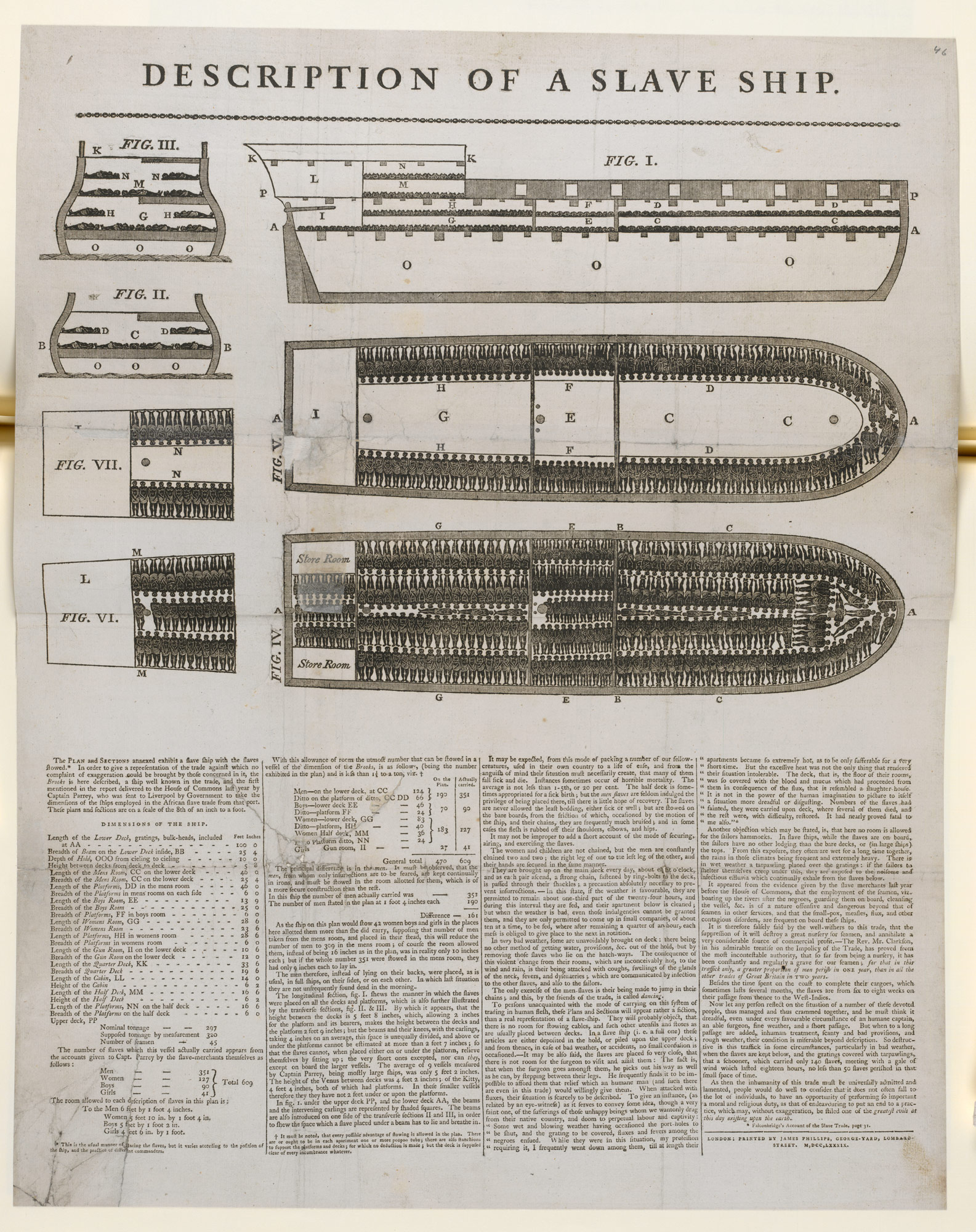
From The History of the Rise, Progress, and Accomplishment of the Abolition of the African Slave-Trade by the British Parliament, London, 1808 (British Library). The image dates to 1787, but it circulated later in many different versions.
The lasting power of slave ship diagram
One image, however, stands out for its power and longevity: a schematic diagram of the interior of the slave ship “Brookes,” created in 1788 in England by an organization seeking to abolish slavery. [1] This diagram (and the text that accompanied it) revealed how tightly enslavers packed human cargo in the lower decks of the ship (allotting six feet for men, less for women and children). With this image we see at a glance how hundreds of enslaved people were chained together without room to move and sailed across the Atlantic. In the case of this particular ship, 454 people were crammed into the hold after a stop on the west coast of Africa, after which it sailed to islands in the Caribbean (most slave ships from Africa sailed to South America and the Caribbean). Out of the 12 million people who were forced into slavery during the years that the Atlantic slave trade operated, approximately one third died before leaving Africa or during this “Middle Passage” by boat. [2]
Of the thousands of images made in the 18th and 19th centuries regarding slavery, the slave ship diagram has had particular resonance. For more than 200 years it has moved viewers, aided teachers, and inspired artists to repurpose it.
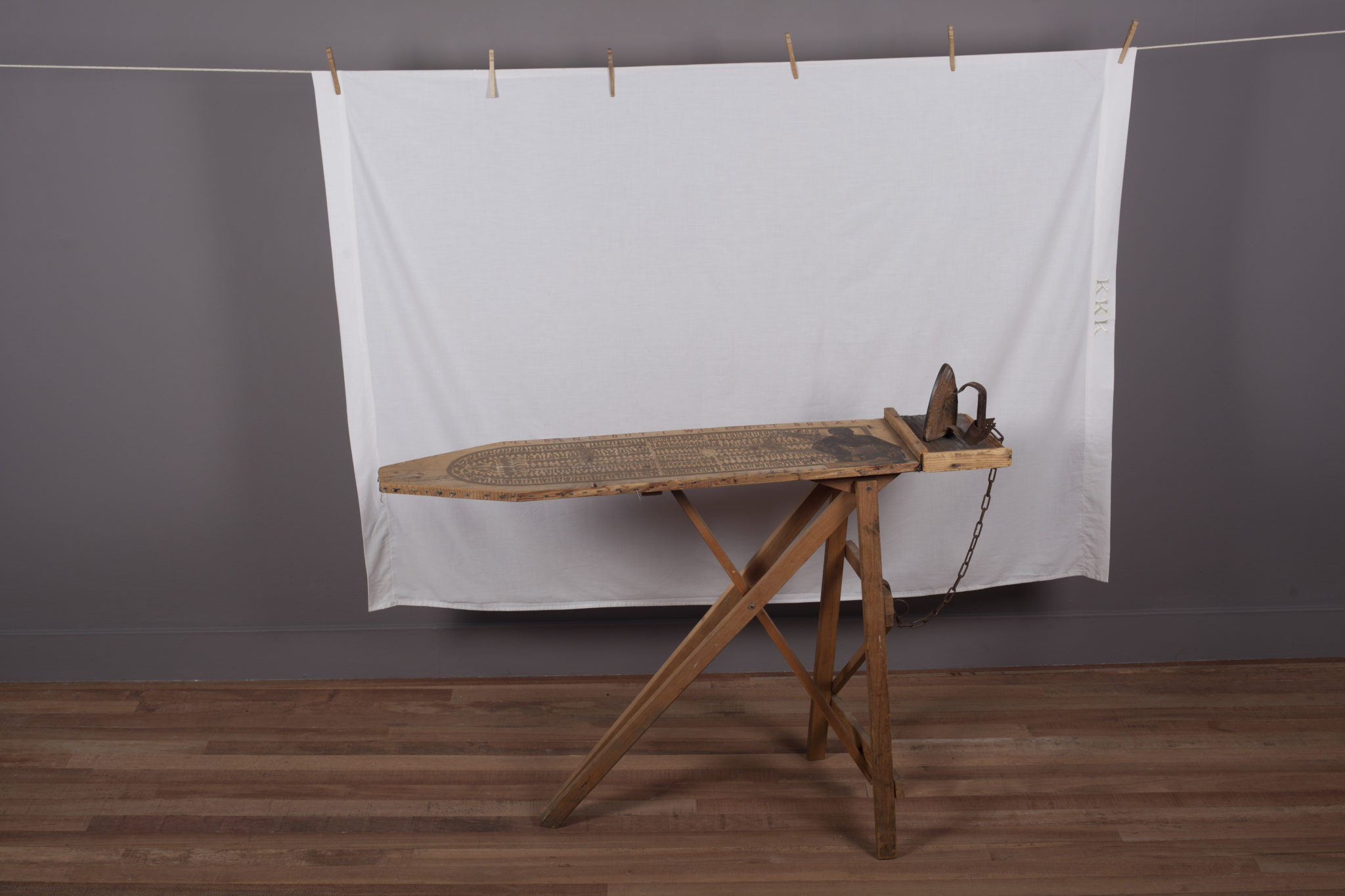
Betye Saar, I’ll Bend But I Will Not Break, 1998, mixed media including vintage ironing board, flat iron, chain, white bedsheet, wood clothespins, and rope, 203.2 x 243.8 x 91.4 cm (Los Angeles County Museum of Art) © Betye Saar
For example, in I’ll Bend but I will not Break, contemporary artist Betye Saar created a poignant image not of slavery per se, but of the experience of remembering the trauma of slavery. She combined an ironing board imprinted with the 18th-century diagram of the slave ship beside a 19th-century image of a “Mammy” figure (a racist caricature of an enslaved Black woman who cooked meals and cared for white children).
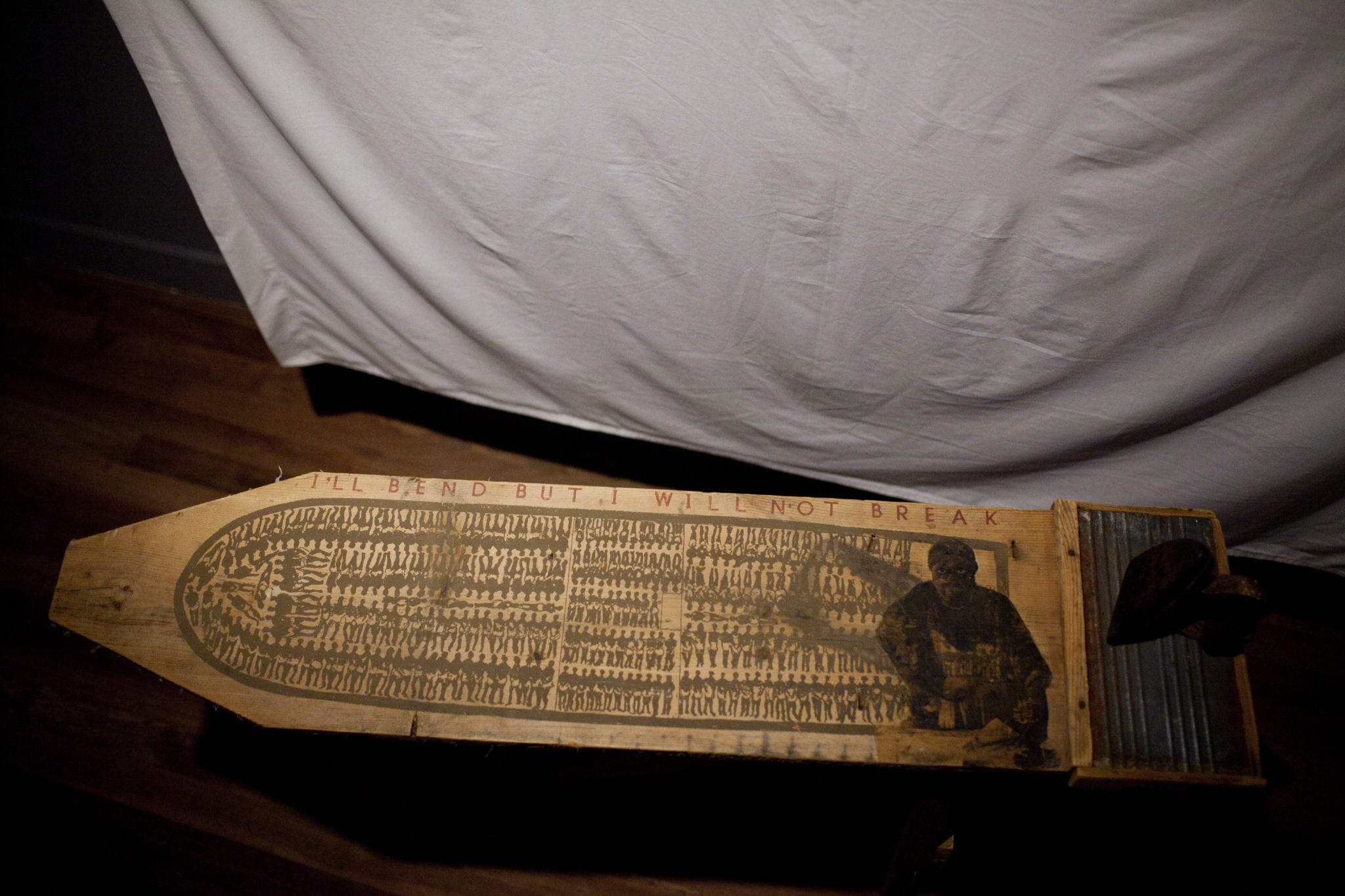
Ironing board (detail), Betye Saar, I’ll Bend But I Will Not Break, 1998 (Los Angeles County Museum of Art) © Betye Saar
Behind, the letters “KKK” (for Ku Klux Klan—a white supremacist terrorist organization that threatened and murdered Black people and their political allies) are barely visible on the sheet in the background, which has been pinned to a laundry line hung across the corner of a room. A chain keeps the iron attached to the ironing board. This image joins references to the beginnings of enslavement to the oppression and violence suffered by Black people in the United States in the 20th century, and serves to, as Saar put it, “jab the memory—to remind people of their history.” [3]
Let’s take a moment to recount that history.
The Middle Passage
Beginning in 1492, Europeans began to seize land in North America (including the Caribbean islands) and in South America. Forced labor, diseases carried by Europeans, and enslavement in some areas devastated Indigenous populations.
At the same time, Europeans discovered the huge profits possible in the cultivation of sugar, mining, and other industries and rapidly began to expand their conquest of land and people. Africans—whom the Portuguese had begun forcibly enslaving to work in sugar colonies off the coast of Africa in the late 1400s—quickly became the target of an immense international slave trade to support the sugar plantations of the Western Hemisphere. Slave traders in the ports of West Africa sold people who had been kidnapped or taken as prisoners of war farther inland, practices which escalated as Europeans looking to extract resources from the Americas drove up the demand for enslaved laborers. As a result of centuries of exchange with Europe and Asia, Africans had developed immunity to the diseases that had devastated the Indigenous populations in the Americas. Enslaved Africans were brought to the Americas in ever increasing numbers between the 16th and early 19th centuries. Africans came to make up the overwhelming share of enslaved people.
Slavery and Blackness
In the British colonies (what would become the United States), bondage and skin color were not at first inextricably tied together: free people of color, white indentured servants, and people with Indigenous ancestry complicate the notion that all white people were free and all Black people were enslaved. But over time colonial governments enacted laws that codified slavery and tied it to Blackness.
By 1640, Black people in Virginia colony, for example, were being held as slaves for life, and by the 1660s, the colony’s laws defined slavery as a status that passed through the mother. By 1680, Blackness had become synonymous with enslavement throughout much of the British colonies, and liberty the province of whiteness.
By the late 17th century, slavery in the thirteen British colonies in North America had several unique characteristics compared to slavery in other times and places. First, slavery was for life: enslaved people had no possibility of becoming free except by escape, self-purchase (which was rare), or by voluntary manumission. Second, it was heritable: an enslaved woman’s children were also enslaved for life, regardless of the status of their father. Lastly, and most importantly, slavery became race-based: Africans or Afrodescendants were subject to enslavement, and white people were not.
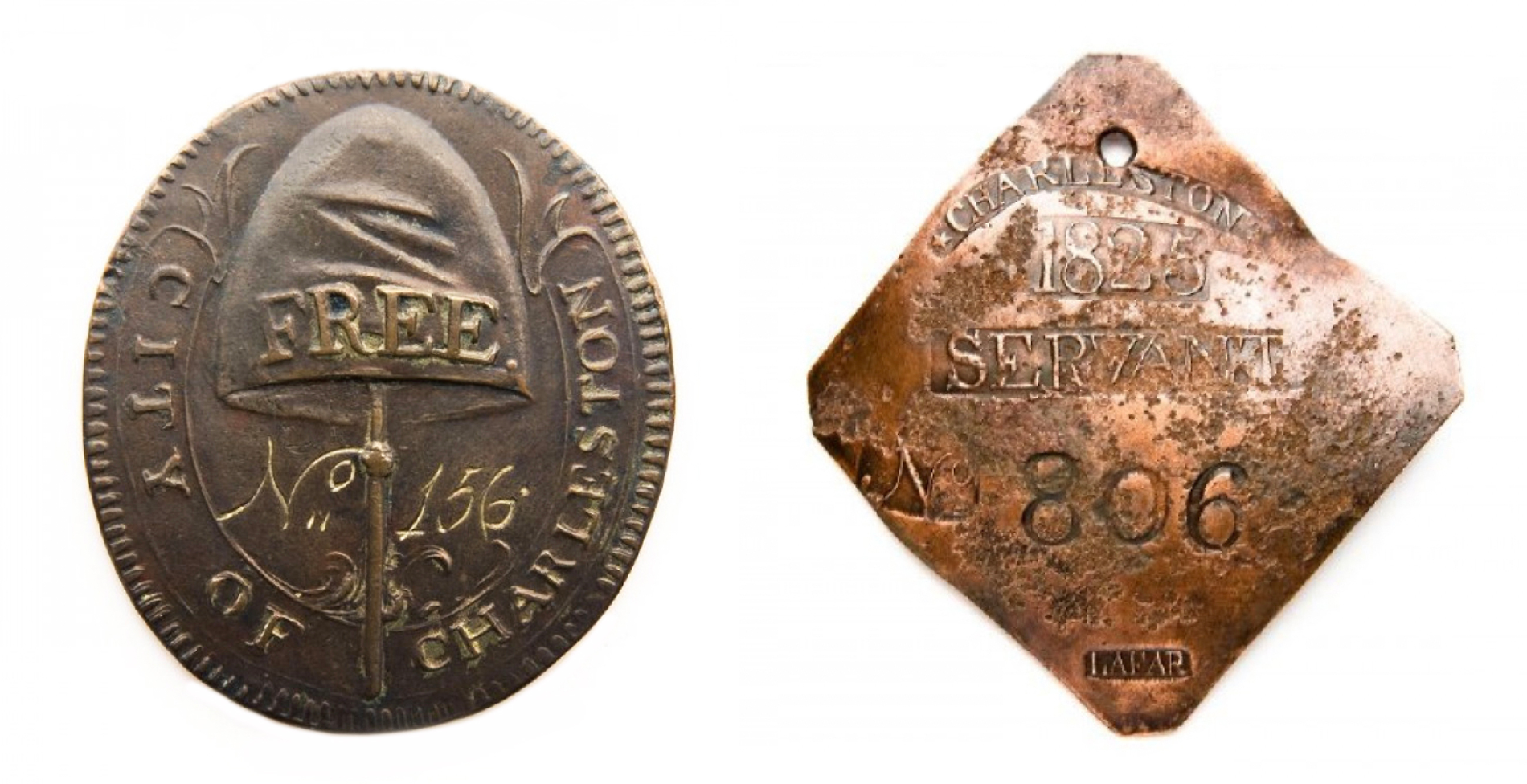
Badges worn by people of African descent in Charleston, South Carolina. The badge on the left was issued to a free person of color during the 1780s. The badge on the right was issued to an enslaved person (“servant” was a euphemism for slave) in 1824. Left: Free badge, 1783–89, copper, 1.457 x 1.614 inches; right: Slave badge, 1825, copper, 2.717 x 2.559 inches (both, The Charleston Museum)
Enslaved people commonly worked directly for their owners but might also be hired out or rented for a fee. In Charleston, slaveholders forced enslaved people who were hired out to wear a ticket or metal badge (issued by the city) in a visible place. [4] For a brief time in the 1780s, Charleston even issued badges for its free Black population, an expression of the surveillance and control whites exercised over all Black people in the city. The copper badge on the left dates to this period. The badge features a pileus cap, a hat worn by ancient Roman slaves upon receiving their freedom. The copper badge on the right dates to decades later (1824) and was worn by an enslaved person. The badge is typical in that it is stamped with the year of issue, a number, and an occupational category. “Lafar” (on the bottom) identifies the silversmith who made it, but the wearer is only identified as “servant” (a euphemism for slave). It is likely that the person forced to wear it worked in a city household as a domestic servant.
It is important to note, however, that slavery did not only exist in the territories then controlled by the United States. In what is today New Mexico and elsewhere, there were Native peoples who in some cases had their own traditions of enslaving war captives known as genízaros which began with Spanish colonists in this region during the 16th century.
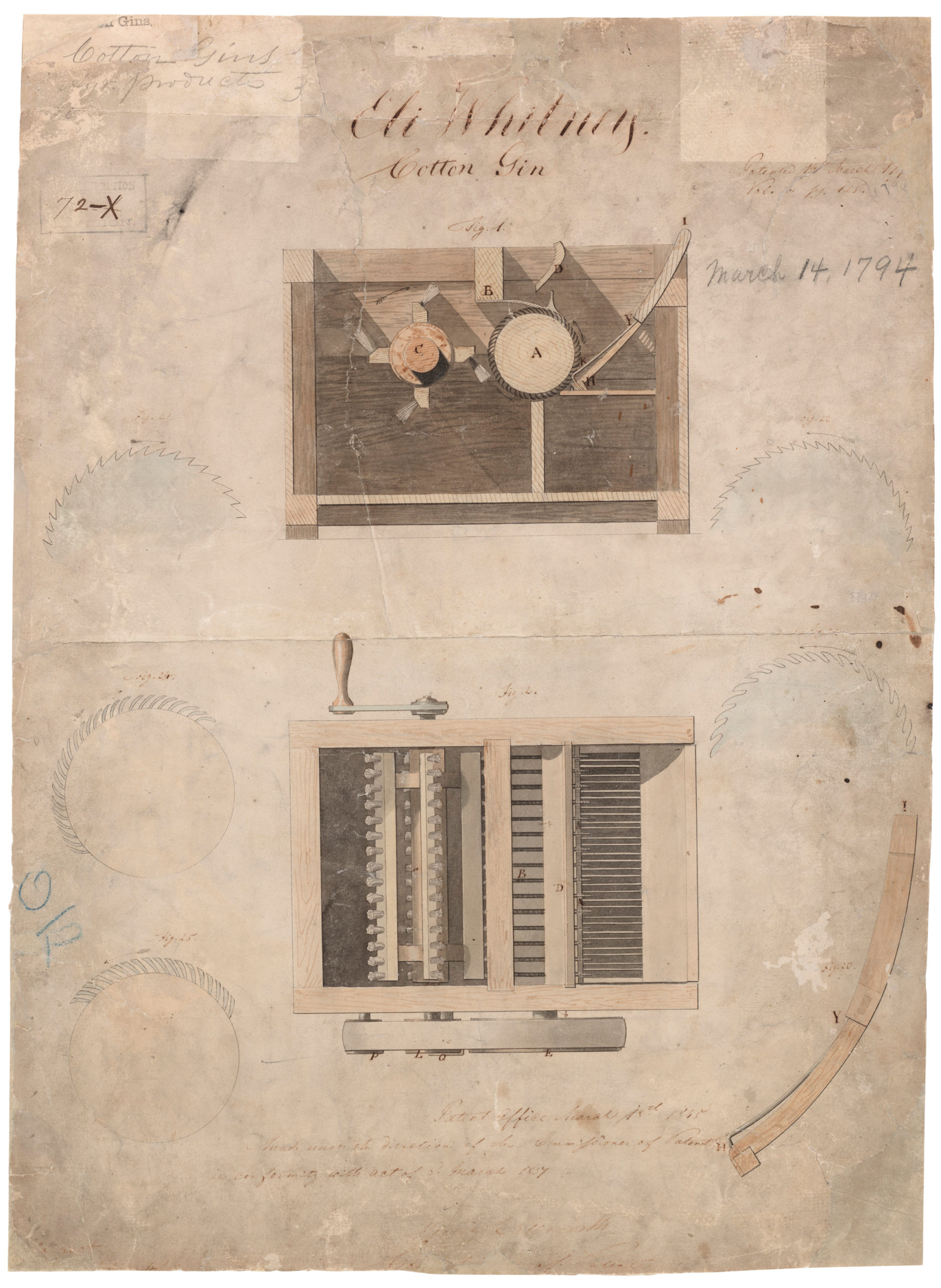
Eli Whitney patent for the cotton gin, March 14, 1794 (Records of the Patent and Trademark Office; Record Group 241, National Archives)
Cotton and slavery
For a variety of reasons, slavery’s profits in the United States grew slimmer in the late 18th century, leading some contemporary observers to predict its gradual extinction. But the 1794 invention of the cotton gin by Eli Whitney changed all that. The cotton gin (“gin” was a short form of “engine”) was a machine that removed seeds from cotton fiber, specifically from short-staple cotton—a significant advance over earlier devices. Whitney’s gin made the crop profitable, pushing plantation owners to expand well into the interior of the South, fueling the demand for land and enslaved laborers.
At the same time, demand for cotton increased with the growth of textile factories in the northern United States and in England. Instead of dying out, the institution of slavery expanded throughout the first half of the 19th century, both in the total number of people who were enslaved (which more than quadrupled) and the amount of territory where slavery was practiced. [5] This growth occurred despite the fact that Congress banned the international slave trade in 1808.
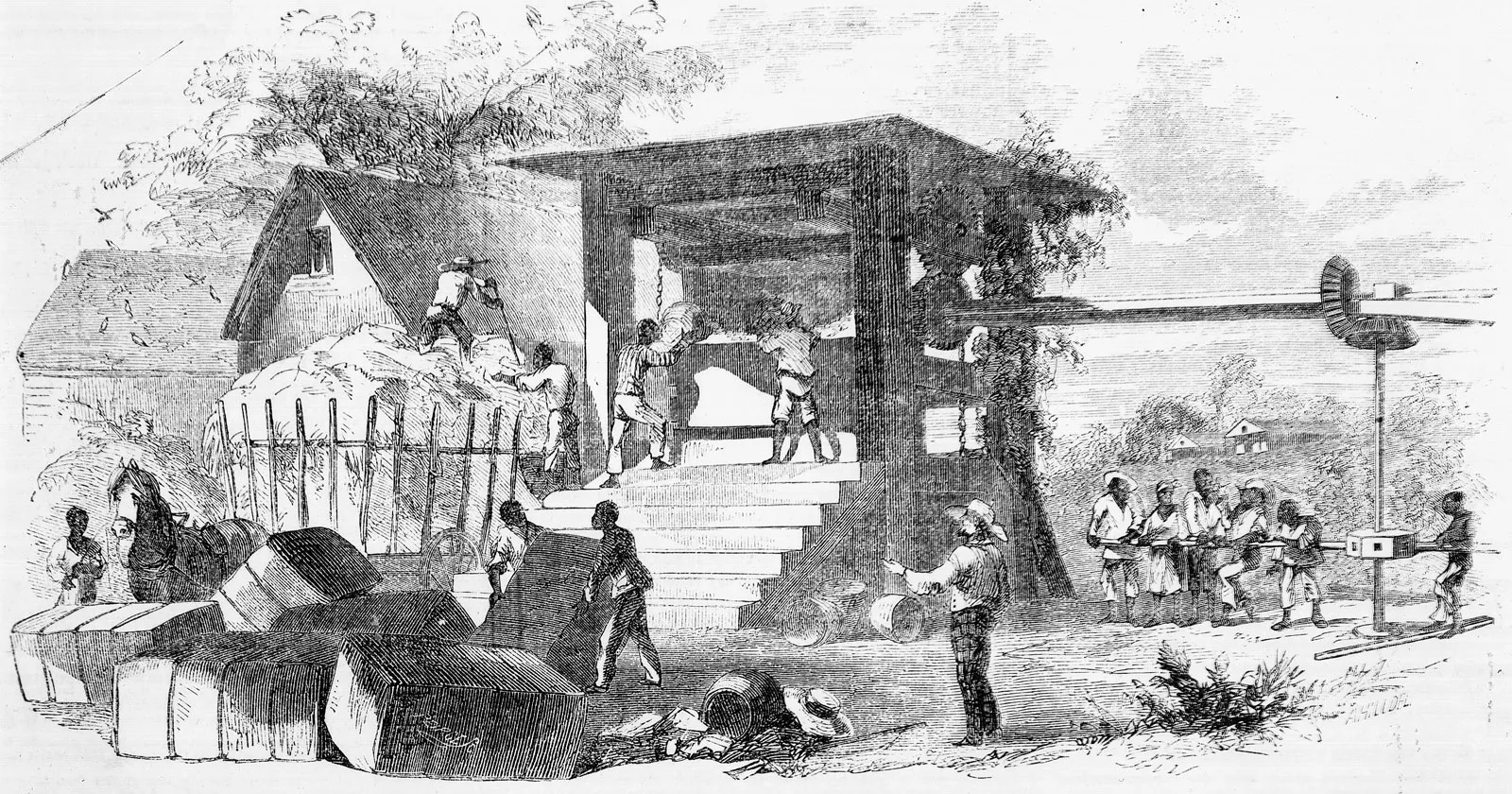
William J. Pierce and A. Hill, “Cotton Pressing in Louisiana,” Ballou’s Pictorial Drawing-Room Companion, no. 15, April 12, 1856, p. 236.
The process of growing cotton and preparing it for sale involved many steps and significant labor. This image, made for a Boston-based periodical on the eve of the Civil War, illustrates the stages of work involved in pressing cotton into bales. The enslaved men working at the cart on the left move cotton into the press. At the right, others walk in a circle providing power to the press. In the foreground, enslaved men move the finished bales down from the press. A white overseer (center right, wearing a large-brimmed hat and with a rifle at his feet) supervises the work, his arm outstretched.
The engraving (and the text that accompanies it) employs vicious racist stereotypes that were common in both northern and southern periodicals of the time. Here, the only white figure is depicted managing the complex process. His graceful stance contrasts with the disarray of the line of enslaved laborers at the right. The text points out that the enslaved man in the center of this group is shown mocking the overseer, drawing on racist stereotypes of Black people as reckless and foolish. Innovations like the cotton gin and press, along with the economic boons realized from enslaved labor, enabled some white southerners to become incredibly wealthy. In contrast, the enslaved people who worked the cotton fields did not profit from their labor.
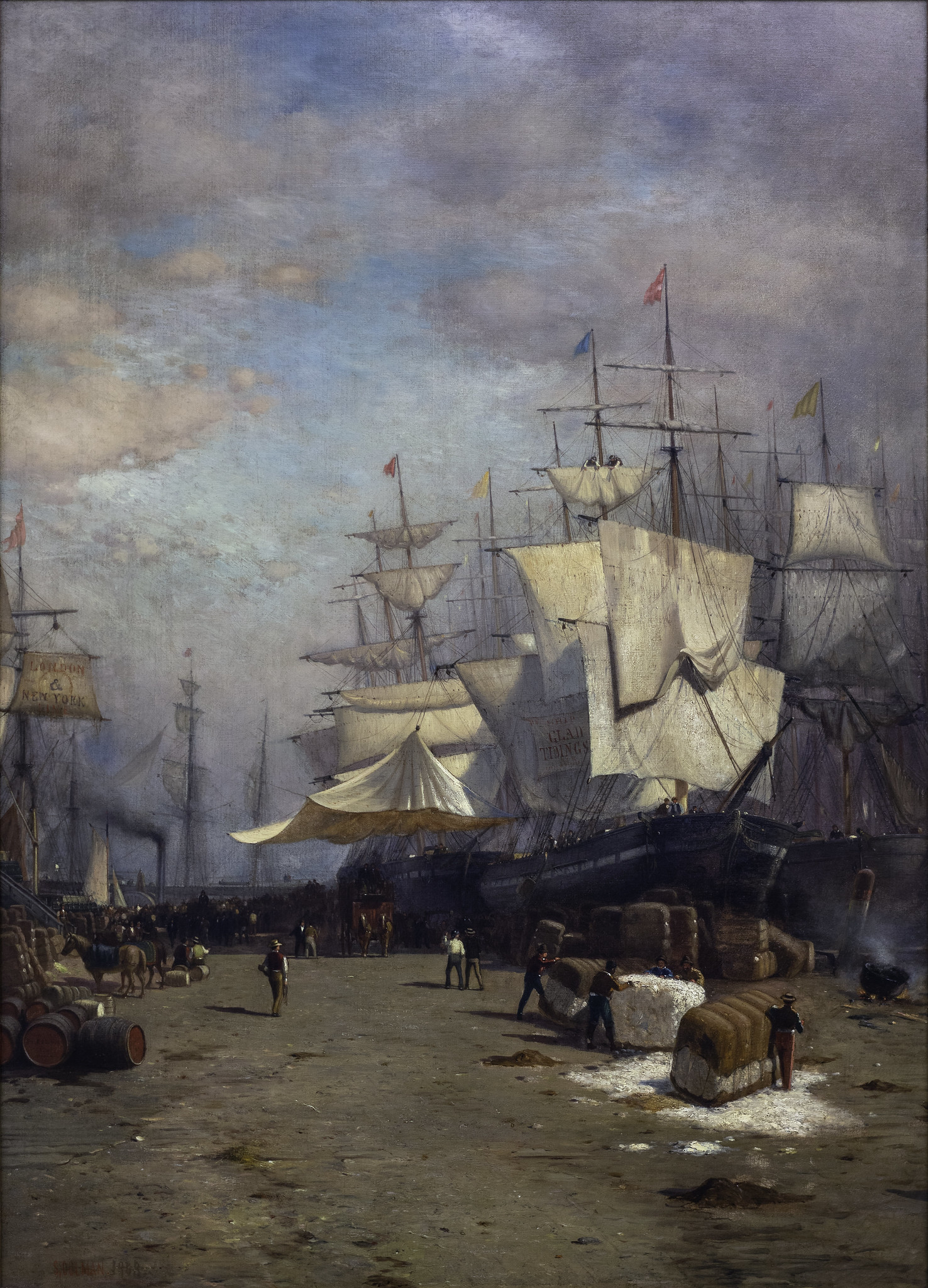
Huge cotton bales can be seen in the right foreground, likely headed for textile mills in the north of England. Samuel Colman, Jr., Ships Unloading, New York, 1868, oil on canvas, 105 x 76 cm (The Terra Foundation for American Art)
Cotton was the most valuable export from the United States, and it supplied the majority of the world’s cotton at this time. Few white southerners could envision a future where cotton did not rule their economy.
A slave society
Slavery was an economic system based on white supremacy where whites enslaved Black people to make use of their forced labor, often under harsh conditions. This system reduced people to commodities bought and sold for profit. An enslaved woman’s owner also owned any children she bore, so the owner’s “investment” grew along with her offspring. In a letter to a young relative, Thomas Jefferson (author of the Declaration of Independence and third president of the United States) wrote of the people he enslaved, “I consider a woman who brings a child every two years as more profitable than the best man of the farm. What she produces is an addition to the capital, while his labors disappear in mere consumption.” [6] The South’s “capital” in enslaved people was its single most valuable asset—in fact, enslaved people were the most valuable asset in all of the United States, more valuable than all manufacturing and railroads combined. [7]
Although three quarters of white southerners did not own any enslaved people themselves, they overwhelmingly supported slavery. Poor white farmers perceived themselves as sharing a racial identity with the “great planters,” who owned hundreds of enslaved people and dominated politics. This outweighed any economic commonality they may have shared with enslaved or free Black people. Assured that they would never be at the bottom of the social ladder, poor whites helped to uphold slavery and often aspired to one day own enslaved people themselves. [8]
We can divide the economic history of U.S. slavery into two periods. The first period ends in 1808, when the U.S. government banned the transatlantic slave trade. The second period, from 1808 through the end of the Civil War in 1865, saw the development of a slave trade within the United States. As the need for enslaved labor expanded across the South, planters purchased enslaved people from places like Shokoe Bottom in Richmond, Virginia. They were then forced to march, often chained together in a coffle, to locations further south or west.
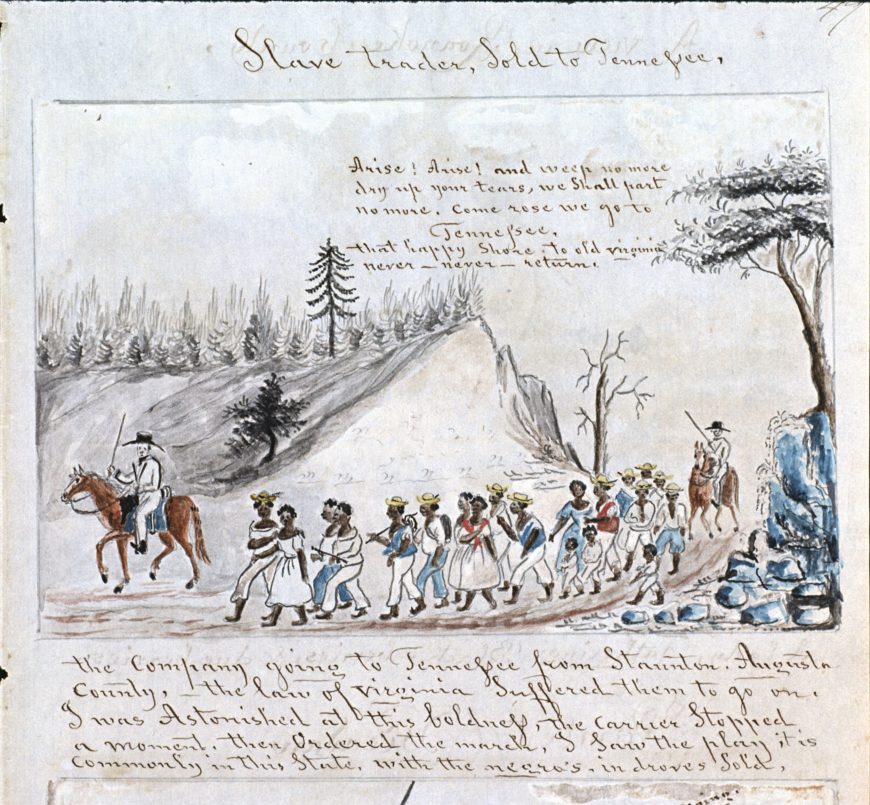
Lewis Miller, Slave Trader, Sold to Tennessee, page from Sketchbook of Landscapes in the State of Virginia, 1853, watercolor and ink on paper (Abby Aldrich Rockefeller Folk Art Center, The Colonial Williamsburg Foundation)
We have a mid-19th-century image of this common sight from Lewis Miller, a Pennsylvania carpenter who traveled widely and kept journals in the form of watercolor sketchbooks. We see twenty enslaved men, women, and children purchased in Staunton, Virginia, being taken in a coffle to Tennessee. Though barefoot, the figures appear neat and orderly, and the composition is framed by the tree on the right, and the figure on horseback on the left. The hill in the center helps to visually unify the group of enslaved men, women and children. Two armed white figures on horseback ensure that no one escapes. The artist wrote down the words he heard sung by the enslaved people, and included them in the upper right:
Arise! Arise! And weep no more
Dry up your tears, we shall part
No more, come rose we go to Tennessee,
That happy Shore, to old Virginia
Never-never-return.as quoted in Maurie D. McInnis, Slaves Waiting for Sale (2011), p. 151
Though these words may at first appear to be hopeful, they embodied a double meaning. The thinker and abolitionist Frederick Douglass noted, “Slaves sing most when they are most unhappy. The songs of the slave represent the sorrows of his heart; and he is relieved by them, only as an aching heart is relieved by its tears.” We should understand the lyrics Miller recorded on the page as deeply mournful. [9]
The experiences of the enslaved
Slavery varied greatly from region to region, from city to country, from estate to estate. Although many enslaved people did live on plantations in the Deep South and worked in cotton fields, enslavement was integrated into all aspects of southern life. Universities owned slaves, and students at universities—usually the sons of wealthy slaveowners—brought enslaved personal servants with them to campus. In cities, enslaved people may have worked as maids, on the docks, as laundresses, or as carpenters. Some enslaved people were skilled artisans, like potter David Drake of Edgefield, South Carolina.
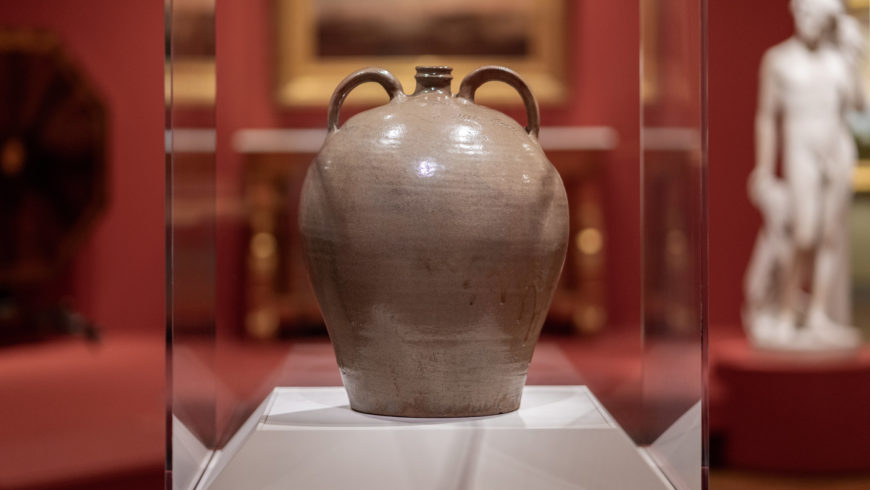
David Drake, Doubled-handled Jug (Lewis J. Miles Factory, Horse Creek Valley, Edgefield District, South Carolina), 1840, stoneware with alkaline glaze, 44.13 x 35.24 cm (Virginia Museum of Fine Arts; photo: Steven Zucker, CC BY-NC-SA 2.0)
This expertly made large double-handled jug is inscribed on one side with the artist’s own name, “Dave” (for David Drake) as well as the name of his enslaver, “L Miles” (for Lewis J. Miles).
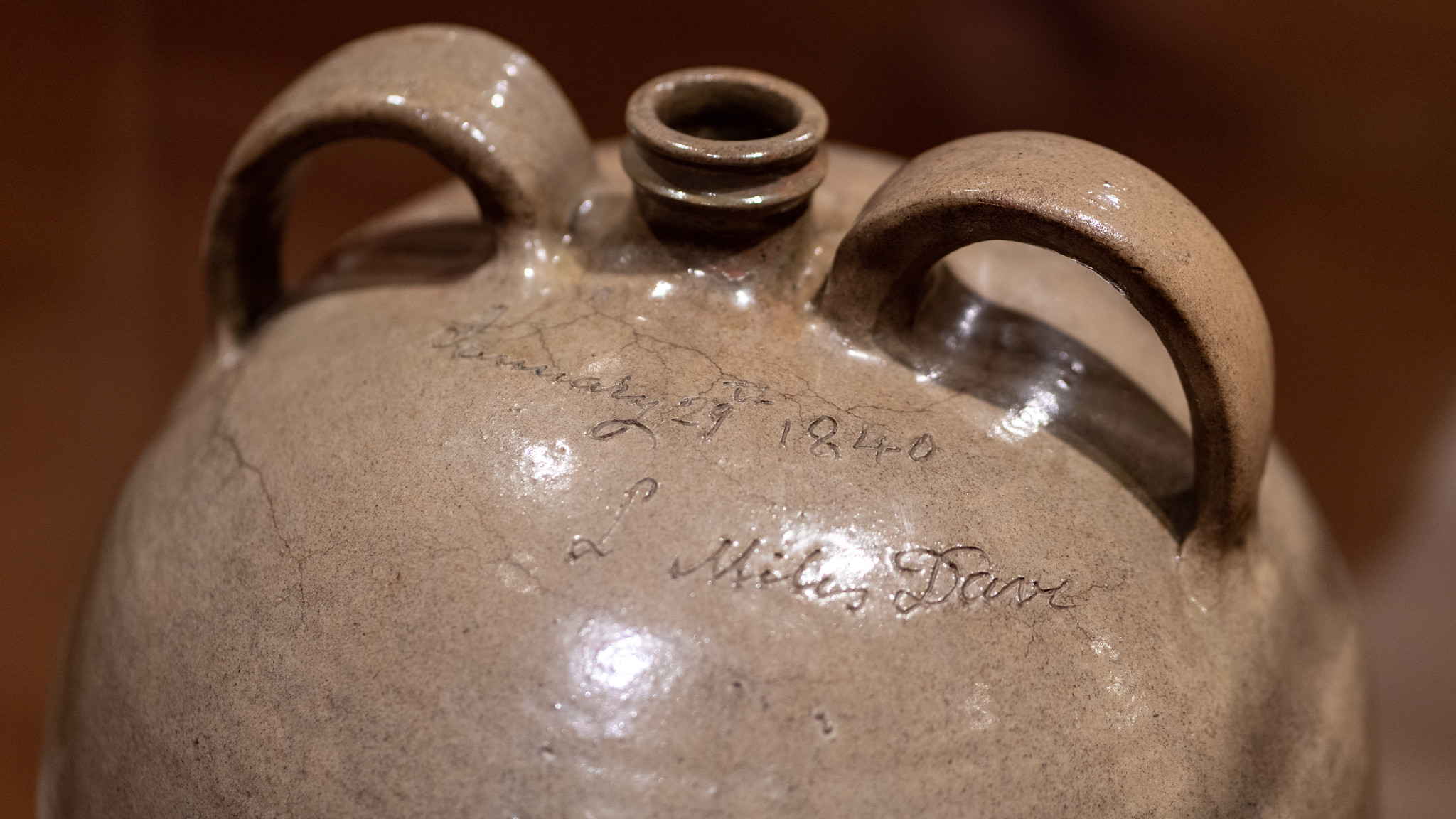
Names and date (detail), David Drake, Doubled-handled Jug (Lewis J. Miles Factory, Horse Creek Valley, Edgefield District, South Carolina), 1840, stoneware with alkaline glaze, 44.13 x 35.24 cm (Virginia Museum of Fine Arts; photo: Steven Zucker, CC BY-NC-SA 2.0)
The opposite side of the shoulder of the vessel is inscribed with a poem,
Ladys & gentlemens Shoes
Sell all you can: & nothing you’ll loose.David Drake
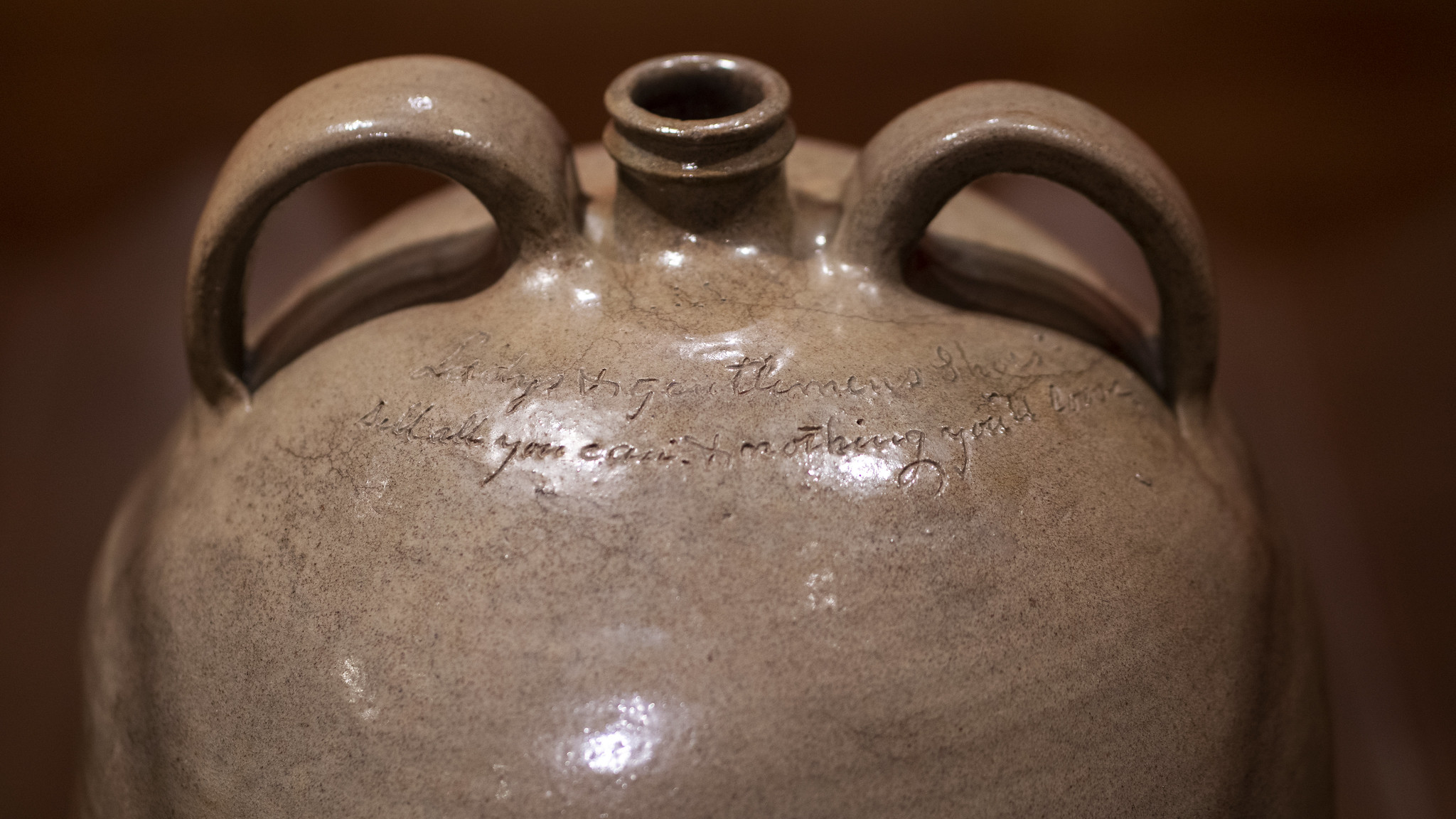
Poem detail, David Drake, Doubled-handled Jug (Lewis J. Miles Factory, Horse Creek Valley, Edgefield District, South Carolina), 1840, stoneware with alkaline glaze, 44.13 x 35.24 cm (Virginia Museum of Fine Arts; photo: Steven Zucker, CC BY-NC-SA 2.0)
Works by David Drake are extremely rare examples of objects produced by enslaved people that can be identified with a particular maker. Even more uncommon is the fact that this pot is inscribed with text written by the artist at a time when literacy was illegal for the enslaved in South Carolina, where this was produced.
Violence and threats were the main methods of coercion that enslavers used on enslaved people. Whippings, along with other forms of physical torture, were commonplace. Enslavers also sold Black children away from their parents or enslaved spouses away from each other when it was financially advantageous to them, or threatened to do so if an enslaved person did not meet certain demands.
For enslaved women and girls, the threat of sexual assault was constant. In addition to the near-limitless power slaveowners exercised over women’s bodies, the rape of enslaved women was incentivized as any children that women bore would become valuable property. The sexual exploitation of enslaved women was an open secret in the South. Mary Chesnut, a white enslaver in South Carolina, observed that in gossip among white women, “every lady tells you who is the father of all the [mixed-race] children in everybody [else]’s household, but those in her own she seems to think drop from the clouds, or pretends so to think.” [10] Harriet Jacobs, who published a memoir of her life in slavery, was relentlessly pursued by her enslaver and feared that his wife would kill her out of jealousy. [11]
Resistance and uprisings
It was extremely difficult for an enslaved person to fight back against the slave society of the South, where they were oppressed by laws, individuals, and even the landscape, as some plantations were so rural as to make each “a little nation of its own,” in the words of one formerly enslaved man. [12] The tie between Blackness and slavery aided whites in constantly monitoring people of color to prevent attempted rebellion or escape. But enslaved people did fight back, in ways both big and small. Everyday resistance could take the form of breaking tools, feigning sickness, or slowing the pace of work. Some enslaved people, especially skilled workers like smiths or seamstresses, negotiated with their enslavers to purchase themselves or their family members by hiring out their labor and putting a portion of their wages toward freedom.
Some enslaved people escaped to northern states, Canada, or after 1837, Mexico, where slavery was illegal. Enslaved people who lived in a border state or near a body of water (as boats provided the fastest means of transportation at the time), had the best chances of escape. Tens of thousands of enslaved people in the first half of the 19th century also escaped through the “Underground Railroad,” a network of abolitionists (both whites and free people of color) who sheltered refugees on their way to freedom. The most famous Underground Railroad “conductor” was Harriet Tubman, who escaped from slavery in Maryland in 1849 and then returned to the South more than a dozen times in the decade that followed to assist others in escaping. [13]
Enslaved people also resisted through coordinated uprisings, which occurred with regularity. Southern whites were terrified of uprisings and tried to suppress news of rebellion from reaching enslaved people, but often failed. News of the successful Haitian Revolution ending slavery in 1804 inspired several uprisings in the United States.
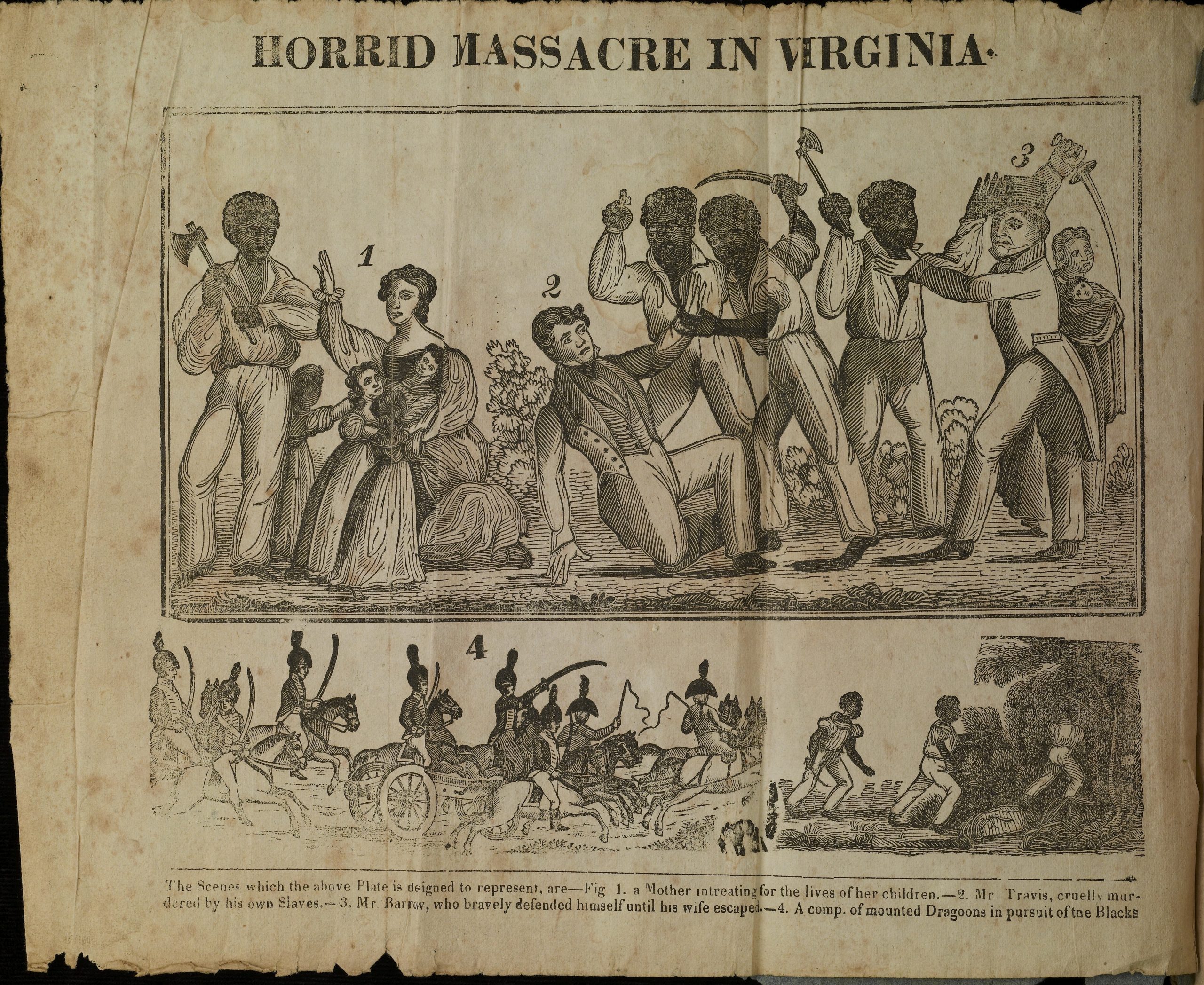
Woodcut depicting Nat Turner’s uprising, 1831 (University of Virginia Special Collections)
In 1831 Nat Turner led a group of enslaved people in a rebellion in Southampton County, Virginia, which resulted in the deaths of 60 white people and widespread fear and retribution (approximately double that number of Black people were killed by militias and mobs). This event prompted the General Assembly of Virginia to debate whether to abolish slavery through gradual emancipation, attempt a colonization scheme (freeing enslaved people but forcing them to emigrate to Africa), or continue with slavery as it existed. After six weeks of debate, the General Assembly decided not to pursue any steps toward emancipation, instead cracking down on gatherings of free and enslaved Black people. [14] One wonders how the rest of the century might have unfolded had Virginia abolished slavery in the 1830s.
With whites creating and distributing most imagery, uprisings were depicted as savage murders of innocents rather than defensive responses by enslaved people to ongoing violence and oppression. In the woodcut above, for example, we see two registers, clearly labeled for maximum legibility. At the top, and up close, the first figure we encounter is a Black man wielding an axe as a woman and four children plead for mercy. In the second scene, a white man falls to the ground as he is outnumbered and assaulted by two Black men who tower above him, one of whom wields a sword. In the final scene on the right, a standing white man with a sword engages in a fight with an axe, while a white woman carrying an infant wrapped in her cloak, moves to the right. Along the bottom, we see a more expansive view of white soldiers on horseback pursuing Black figures. The woodcut, intended for a white audience, tells a story that moves from violence against white women and children to a reassuring scene of the Black culprits of the rebellion (just three men are shown) being chased and punished.
Absence and presence
The visual record of slavery is severely limited, yet it tells us a great deal. We read as much from its absences as from its presences. Much of what was made has likely been lost to time, discarded by the same people who worked to preserve the houses, furnishings, and papers of wealthy enslavers. Instead we must imagine the hearts behind copper badges worn around necks, and conjecture what the hands that were forced into manacles would have made had they been able to make whatever they chose.




